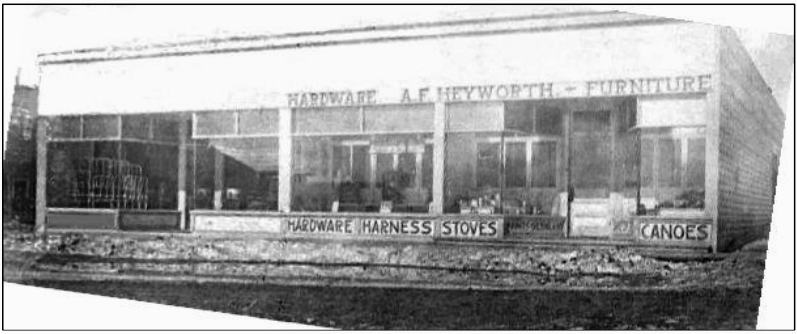The First Hardware Store in Hearst.
By Ernie Bies,
February 4, 2022.
Alfred Heyworth's hardware store was one of the four buildings to survive the fire of 1914 that destroyed the town of Hearst.
The 1921 census lists Alfred Heyworth as a 47-year-old single man from England, occupation, merchant. The Hearst Town Council minutes of Nov. 22, 1922 indicate an account at Heyworth's for the lock-up with a payment to Constable Robert Sharp of $2.50.
It appears that Heyworth's store was on the corner of 8th and George St according to an unpublished history of Hearst by Ken Sprickerhoff who grew up here in the 1930s. He described the town of his youth as being comprised of two blocks from the Waverley Hotel (on Tenth St.) to Heyworth's store (on 8th St.). Sprickerhoff also talked about Vital Brisson owning a hardware store in the 1930s in the same building and perhaps the same location as Heyworth's store. He also mentioned the Paradis "funeral" parlour where the deceased were stored in a shed on 8th St. This is consistent with later reports of Halle Hardware in the same building which sold furniture and caskets. This location was also the site of the Brisson and DeHaitre Hardware stores over the years.
Heyworth's store is mentioned in this very dramatic newspaper account of the fires of 1914, which I have transcribed below.
The Toronto Daily Star, Friday, July 17, 1914 reported – "HAD ONLY BUCKETS TO FIGHT FIRE AT HEARST – Three Hundred Homeless and Hungry – Refugees Arrive in Cochrane – FOUR BUILDINGS LEFT – Spent Night and Day Huddled on Track with Fire All Around"
"Cochrane, July 17 – Their Homes, even their town, destroyed by fire, three hundred refugees from Hearst, 134 miles west of Cochrane, on the N.T. Railway, reached here yesterday afternoon in their flight for food and safety. The residents have been fighting bush fires for the past two or three days, with the very scanty appliances at hand. Fanned by a strong wind, the flames gradually ate their way towards the town yesterday until the fight became hopeless, and the inhabitants fled for their lives to the nearest place of safety, which was the track. Here they found refuge, and no one was hurt. About four hundred or five hundred people have been rendered homeless, and most of them are quite destitute.
Losing the Fight With Buckets
"On the relief train which arrived here there were from two to three hundred homeless people, and they are being taken care of. They all tell stories of a two or three days and nights fight with fire, nothing but a bucket brigade being available. Several times they thought that the fire had been conquered, but each time it sprang up again, and the weary fight was resumed. On Wednesday the wind almost blew a cyclone, and men who had been through the Porcupine fire began to make for the tracks, fearing for their lives. At 3 o'clock it got beyond control, and everyone took refuge on the Transcontinental Railway tracks. Mr. M.J. O'Brien of the firm of O'Brien, McDougall & O'Gorman, who have their headquarters at Hearst, took all the homeless people to his camps at Pit 7, where they were all fed, and the women and children housed. They passed the night and the next day till the train arrived in the middle of smoke and flame and torrid heat.
Only Four Buildings Saved

Photo courtesy of Dorothy Girard Leger, enhanced by Rob Martin.
"About a month ago a bush fire invaded the town and destroyed nineteen houses. Yesterday it finished its work. All the houses were of wood with the exception of the roundhouse and station of the Transcontinental, which are both saved. The only other buildings saved are Jamieson's meat store and Heyworth's store. Bush fires have encircled the little town, 134 miles west of Cochrane for some time. It is largely a railway construction town, as O'Brien, McDougall & O'Gorman make it their headquarters, and when the Transcontinental Railway construction was busiest, this was the base for several thousand men. There must be a thousand men working on the line now, but they were away from the town. All the buildings of the O'Brien, McDougall & O'Gorman Company are gone, and most of the buildings erected by the Government railway for this divisional point."
Can you provide corrections or comments?
Please report technical issues to: